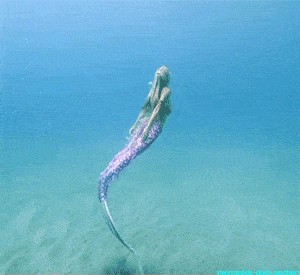Mermaiding, the enchanting art of swimming with a monofin, combines athleticism, grace, and a touch of fantasy. If you dream of gliding through the water with the elegance of a mermaid or merman, this comprehensive guide from CONDUCT.EDU.VN will provide you with the essential steps, techniques, and safety considerations to embark on your mermaiding journey. Dive in to discover mermaid swimming, mermaid tails, and underwater exploration!
1. Cultivate Water Comfort and Confidence
Before donning a tail, prioritize comfort and confidence in the water. This foundation is crucial for both safety and enjoyment.
1.1 Overcoming Facial Submersion Hesitation
Many beginners experience discomfort putting their face underwater. Address this common challenge with the following technique:
- Bobbing Drills: Submerge your face, exhale completely, and resurface for a breath. Repeat this bobbing motion ten times for three rounds, incorporating 30-second to 1-minute breaks between each round. This will help you develop a natural breathing rhythm and acclimate your face to the water.
1.2 Mastering Underwater Exhalation
Proper exhalation is vital for staying submerged comfortably. Practice humming underwater to regulate air release:
- Humming Technique: Inhale deeply through your mouth above the water, then exhale gently through your nose while submerged, humming to control the airflow. This prevents excessive air expulsion, allowing you to remain underwater for longer durations.
2. Refine Fundamental Swimming Skills
Mermaiding builds upon core swimming abilities. Hone these essential skills to enhance your mermaid form.
2.1 Executing the Streamline
The streamline position minimizes drag and maximizes propulsion underwater.
- Streamline Practice: Push off the pool wall in a streamlined position (arms extended tightly overhead, biceps pressed against your ears, hands stacked). Maintain this form while kicking as long as possible. Repeat five times, resting for one minute between each repetition. This drill cultivates body awareness and teaches you how to move efficiently through the water.
2.2 Breath-Holding Techniques
Underwater photography and extended glides require breath control.
- Breath-Holding Exercises: Explore resources like freediveuk.com for specialized breath-holding drills. Remember that progress takes time, so be patient and consistent with your practice. Always prioritize safety and never practice breath-holding alone.
2.3 Underwater Vision
Opening your eyes underwater enhances the mermaiding experience.
- Gradual Acclimation: Begin with goggles to protect your eyes. As you become more comfortable, gradually remove them for brief periods, noting any irritation. Eye drops can alleviate discomfort caused by chlorine. Regular swimming can help your eyes adapt to chlorinated water.
3. Gear Up for Mermaiding
Selecting the right equipment is essential for safety, performance, and aesthetics.
3.1 Starting with Swim Fins
Before advancing to a monofin, master swimming with individual fins.
-
Independent Fin Training: Practice with separate fins to develop leg strength and coordination. This provides a solid foundation for the monofin’s unique movement pattern.
Alt text: Comparison chart of different mermaid tail options, detailing features, materials, and price points, useful for beginners in mermaiding.
3.2 Understanding Monofins
The monofin is the key component of a mermaid tail, propelling you through the water with powerful undulations.
- Monofin Types: Monofins vary in size, shape, and stiffness. Choose one that matches your strength and experience level. Softer monofins are generally recommended for beginners.
- Safety Considerations: Ensure the monofin fits snugly and comfortably. Practice removing it quickly in case of emergency. Never swim in a mermaid tail in deep water without supervision.
3.3 Selecting a Mermaid Tail
Mermaid tails come in a variety of materials, designs, and price ranges.
- Fabric Tails: Ideal for beginners, fabric tails are affordable, lightweight, and easy to maneuver.
- Silicone Tails: Silicone tails offer a realistic appearance and enhanced performance, but they are significantly more expensive and require more care.
4. Master the Mermaid Kick
The dolphin kick, adapted for the monofin, is the primary propulsion technique in mermaiding.
4.1 Dolphin Kick Fundamentals
The dolphin kick originates from the core, not the knees.
- Streamline with Undulation: Push off the wall in a streamlined position with arms at your sides. Initiate the dolphin kick with five large undulations, focusing on engaging your core and minimizing knee bend. Repeat five times with rest intervals.
- Streamline with Forward Arms: Repeat the drill with your arms extended in front of you in a streamlined position.
- Fin Introduction: Perform the same two drills with individual fins to build strength and coordination.
- Monofin Integration: Finally, incorporate the monofin and mermaid tail, maintaining the core-driven undulation.
4.2 Visual Learning Resources
Supplement written instructions with video tutorials. Numerous online resources demonstrate the proper dolphin kick technique for mermaiding.
4.3 Core Engagement
Activating your core muscles is crucial for generating power and control in the mermaid kick.
5. Expanding Your Mermaiding Skills
Once you’ve mastered the basics, explore these techniques to enhance your mermaiding abilities.
5.1 Skulling
Skulling involves using hand movements to maintain buoyancy and control direction.
- Hand Motion: Move your hands back and forth in a sweeping motion, using the water’s resistance to stay afloat. This technique is often used to create a dramatic “popping up” effect.
5.2 Underwater Posing
If you’re interested in underwater photography, practice posing gracefully underwater.
- Body Awareness: Be mindful of your body position and facial expressions. Practice in front of a mirror to refine your poses.
- Breath Control: Coordinate your poses with your breath-holding capacity. Exhale slowly to avoid creating bubbles that obscure your face.
6. Prioritizing Safety in Mermaiding
Mermaiding can be physically demanding, so prioritize safety at all times.
6.1 Never Swim Alone
Always mermaid with a buddy or in a supervised environment.
6.2 Awareness of Open Water Hazards
Open water presents unique challenges, including currents, murky visibility, and marine life.
- Currents: Be aware of currents and avoid swimming in areas with strong flows.
- Visibility: Reduced visibility can make it difficult to navigate and spot potential hazards.
- Marine Life: Be respectful of marine life and avoid disturbing their habitat.
 Mermaid GIF how to swim like a mermaid
Mermaid GIF how to swim like a mermaid
6.3 Physical Fitness
Mermaiding requires a reasonable level of fitness.
- Swimming Proficiency: Be a competent swimmer before attempting mermaiding.
- Cardiovascular Health: Ensure you have adequate cardiovascular fitness for sustained swimming activity.
- Strength and Flexibility: Core strength and flexibility are essential for performing the mermaid kick effectively.
7. Joining the Mermaiding Community
Connect with fellow mermaids and mermen to share experiences, learn new skills, and build friendships.
7.1 Mermaid Schools
Mermaid schools offer structured lessons, expert guidance, and a supportive community.
- Skill Refinement: Learn advanced techniques and refine your mermaid kick.
- Trick Development: Explore underwater tricks and choreography.
- Community Building: Connect with other mermaids and mermen.
7.2 Online Forums and Social Media Groups
Numerous online communities cater to mermaiding enthusiasts.
- Information Sharing: Access tips, advice, and resources from experienced mermaids and mermen.
- Inspiration and Motivation: Share your progress and connect with others who share your passion.
8. Consider Swimwear Options
Choose swimwear that is both functional and aesthetically pleasing.
8.1 Jolyn Swimwear
Jolyn Swimwear offers durable and secure swimwear options suitable for mermaiding.
- Secure Fit: Designed to stay in place during vigorous swimming activity.
- Vented Tops: Vented tops prevent drag and enhance comfort.
9. Addressing Common Challenges
New mermaids often encounter similar challenges. Here’s how to overcome them:
9.1 Monofin Discomfort
Ensure your monofin fits properly and doesn’t cause chafing.
- Proper Sizing: Consult sizing charts and try on different monofins to find the best fit.
- Protective Gear: Wear socks or neoprene sleeves to prevent chafing.
9.2 Tail Drag
Tail drag can hinder your movement and make swimming more difficult.
- Streamlined Position: Maintain a streamlined body position to minimize drag.
- Proper Tail Fit: Ensure your tail fits snugly and doesn’t create excess drag.
9.3 Buoyancy Issues
Some individuals may experience difficulty staying submerged.
- Weight Management: Experiment with small weights to achieve neutral buoyancy.
- Lung Capacity: Practice breath-holding exercises to increase lung capacity.
10. Legal and Ethical Considerations
Be aware of local regulations and environmental concerns when mermaiding.
10.1 Permits and Restrictions
Some areas may require permits for swimming with mermaid tails.
10.2 Environmental Responsibility
Protect marine environments by avoiding contact with coral reefs and other sensitive ecosystems.
- Leave No Trace: Pack out all trash and avoid disturbing marine life.
- Reef-Safe Sunscreen: Use reef-safe sunscreen to minimize environmental impact.
FAQ About Mermaiding
Q1: Is mermaiding difficult to learn?
A: Mermaiding requires a combination of swimming skills, core strength, and coordination. While it can be challenging initially, consistent practice and proper instruction can make it accessible to most individuals.
Q2: What are the age requirements for mermaiding?
A: There is no specific age requirement for mermaiding, but it is generally recommended that individuals be strong swimmers and comfortable in the water before attempting it. Children should always be supervised by a qualified instructor or experienced adult.
Q3: Can I mermaid in any body of water?
A: No, it is essential to choose safe and appropriate locations for mermaiding. Avoid swimming in areas with strong currents, poor visibility, or hazardous marine life. Always check local regulations and obtain necessary permits.
Q4: Are mermaid tails safe for swimming?
A: Mermaid tails can be safe when used responsibly and with proper training. It is crucial to learn how to remove the tail quickly in case of emergency and to never swim alone.
Q5: What is the best material for a mermaid tail?
A: The best material for a mermaid tail depends on your budget, experience level, and desired aesthetics. Fabric tails are a good option for beginners, while silicone tails offer a more realistic appearance and enhanced performance for experienced mermaids.
Q6: How do I care for my mermaid tail?
A: Proper care is essential for prolonging the life of your mermaid tail. Follow the manufacturer’s instructions for cleaning and storage. Avoid exposing the tail to harsh chemicals or abrasive surfaces.
Q7: Can I use my mermaid tail for diving?
A: Mermaid tails are not typically designed for diving. The monofin may not provide sufficient propulsion for deep dives, and the tail can restrict movement in emergencies.
Q8: How can I improve my mermaid swimming technique?
A: To improve your mermaid swimming technique, focus on core strength, flexibility, and proper dolphin kick form. Practice regularly, seek guidance from experienced instructors, and watch video tutorials.
Q9: What are the career opportunities in mermaiding?
A: Mermaiding can offer various career opportunities, including mermaid performer, underwater model, mermaid instructor, and mermaid tail designer.
Q10: Where can I find more information about mermaiding?
A: You can find more information about mermaiding from online forums, social media groups, mermaid schools, and websites like CONDUCT.EDU.VN, which offer comprehensive guides and resources on ethical and responsible conduct in various fields, including recreational activities.
Conclusion
Mermaiding is a captivating activity that combines athleticism, artistry, and a connection with the underwater world. By following this beginner’s guide, you can embark on your mermaiding journey with confidence and safety. Remember to prioritize water comfort, master fundamental swimming skills, select appropriate gear, and join the mermaiding community.
For more in-depth information on ethical conduct and safety guidelines, visit conduct.edu.vn at 100 Ethics Plaza, Guideline City, CA 90210, United States. You can also contact us via Whatsapp at +1 (707) 555-1234. We are committed to providing comprehensive resources to ensure a safe and enjoyable mermaiding experience. Dive in and explore the magical world of mermaiding!
